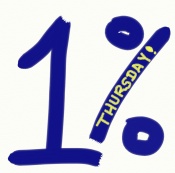Last week on 1% Thursday I told you we were going to talk a little more about reading food labels. I also said that this could have a major impact on your health – especially if it’s something you’ve never really taken the time to do before.
So today we’re going to look at 8 guidelines to help you be a better food label reader. Though I said these are for the migraineur, they should also be generally useful for anyone with cluster or chronic headache.
First, there are some things you need to know, if you don’t already. Food labels are not clear, accurate fountains of information. Sometimes they’re very well done, other times they’re downright deceptive. Yes, even in this day and age. Food manufacturers are not required to list every detail of what’s in their food. You need to realize that. And though there are loose regulations, there’s a lot of leeway – caveat emptor (let the buyer beware) is the real rule, just as it always has been.
And one more thing, before we begin. This is not a defense of why certain foods are good or bad for you. We’ve talked about that before, and will again. Today we’re just talking about finding those foods…

The Migraineur’s 8 Rules for Reading Food Labels
Follow these rules by reading the label carefully, especially the ingredients…
- Taglines: Taglines are those many advertising type words on the label that mean… almost nothing. "lite" for example. Meaning… light flavour? Less of it? That’s a brand name? Also could include things like "all natural". "multigrain flavour". even "whole grain". And that ridiculous "real fruit" claim. And let’s make one thing clear – "natural flavor" is not necessarily any better than "artificial flavor". Don’t waste your time with all these. Skip. Most often they’re almost meaningless. You’ll find the real information elsewhere.
- Number of ingredients: A general rule of thumb – the longer the list of ingredients, the greater the chance there’s stuff in there you don’t want in your body. If you want to make a quick decision, watch out for lists that will take you a half hour to read.
- Order of ingredients: Hopefully most of you know this, but generally speaking if something is earlier in the list there’s more of it. I hate to pick on "whole grain", but it drives me crazy how often something claims to be whole grain and then lists something like "white flour" or "enriched wheat flour" first. I’m looking at the label of some popular whole wheat crackers now – enriched flour is the number 1 ingredient. There’s no way to know how much whole wheat flour they added to make the crackers whole wheat, but there’s more white flour than whole wheat. Fail.
- Great-Grandma Rule: If you’re Great-Grandma wouldn’t recognize the ingredient, chances are it’s not good for you. This goes hand in hand with the how-do-you-pronounce-that rule and the what-plant-does-that-come-from rule.
- Et cetera: As I mentioned, food manufacturers don’t have to list every detail. In fact, some packages can claim to have 0 (zero) of something, and in reality have a small amount (can you say trans fat?) Sometimes, though, key ingredients are hidden under phrases such as "natural flavours", "spices" and the like. Hidden in there can be ingredients that could trigger your migraine attack. Watch out for the et ceteras!
- No really, it’s healthy: If a food makes health claims, chances are it’s less healthy. What?? Why is that?! Here’s what happens. A natural food is taken, and things are taken out so that it can be preserved, shipped, made a nicer colour, whatever. Then all the experts try to add back in some health benefits. But all the king’s horses and all the king’s men couldn’t put Humpty together again. The fact it, you’ll find that almost every time the original food has the solid, healthy balance that we’re only starting to understand. If we don’t even understand yet why food is healthy, how can we expect to "manufacture" something better? Claims of health benefits usually mean that it’s a cheap imitation of a whole food which would be 100x better for you.
- Whole foods: Are there issues with buying whole foods? You bet. But after all this stress reading food labels, you’ll find that almost every time you’d be better buying a food with just 1 (one) ingredient. You know, like an apple. Brown rice. Spinach. They don’t have the advertising budget to make the pretty ads and put all the health claims on the label. But they’re amazingly healthy, and the labels will cause you a lot less of a headache.
- Watch for triggers: There are some ingredients to specifically watch for, yes. Now there are literally hundreds of ingredients you could try to learn – I’m trying to simplify things with the above rules and by encouraging you to buy more whole foods. But if you must buy foods with long ingredients lists, common migraine triggers include: anything related to MSG (monosodium glutamate, hydrolized or autolized (anything), malt extract, gelatin, glutamate, yeast extract/food/nutrient, sodium caseinate, textured protein, anything that says natural or artificial flavourings or spices, and more…), artificial sweeteners (such as saccharin, aspartame, sucralose, neotame, acesulfame potassium, and nutrasweet), yeast (especially if it’s fresh), alcohol, white flours (including enriched flour) and sugars (including high fructose corn syrup), nitrates, nitrites – and many more.
I didn’t list the many other ingredients that are harmful or at least controversial, such as partially hydrogenated vegetable oils, BHA and BHT, food colouring, and so on. The list could be huge – and that’s the problem.
Want to make it easy on yourself? Start with Rule 7. Then move to Rule 2,3 and 4 if you must. After that, it gets more complicated, as you can see – and we like simple.
Remember that there are other issues related to migraine triggers besides certain chemicals in foods (which I focused on here). More on migraine and food here.
Some of these ideas, particularly Rules 4 and 6, were passed on by Michael Pollan’s book In Defense of Food. If you’re really ready to move your eating habits to the next level, and want to understand how the food in the grocery store got to where it is today, and especially why Rule 6 is so strangely true, I recommend it to your consideration.
Now, go do your grocery shopping – and see open your eyes to what you’re really buying.




